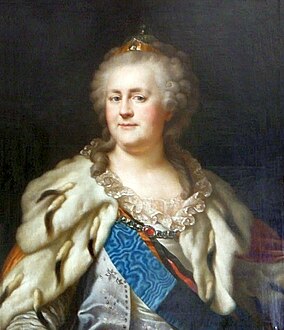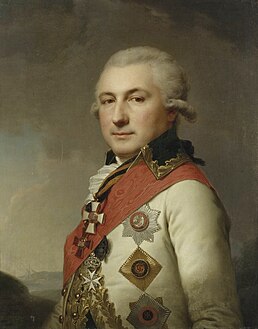Johann Baptist von Lampi the Elder
 From Wikipedia the free encyclopedia
From Wikipedia the free encyclopedia
Johann Baptist von Lampi the Elder | |
|---|---|
 Self-portrait (1808/10) | |
| Born | 31 December 1751 |
| Died | 11 February 1830 (aged 78) |
Johann Baptist von Lampi the Elder (German: Johann Baptist von Lampi der Ältere, Polish: Jan Chrzciciel Lampi; 31 December 1751 – 11 February 1830) was an Austrian-Italian historical and portrait painter. He settled in the Russian Empire after the third and final partition of Poland, enticed by an extremely generous offer from the Tsar.[1]
Life[edit]
Johann Baptist Lampi was born at Romeno in the County of Tyrol to Matteo, or Matthias, Lampi (1698-1780), a decorative painter. Frescoes by his father may be found in many elegant buildings there.[2] He studied art under his father in Verona and later in Salzburg.[3]
In 1773 he went to Trento, where he learned to become a portraitist in canvases and miniatures. He travelled to Innsbruck, then to Vienna, where the Emperor Joseph II appointed him a professor at the Vienna Academy in 1786. That same year, he was invited to Warsaw by the court of King Stanisław II Augustus (pictured). He worked in Warsaw until the complete military Partitions of Poland.[4]
In 1791, he moved to St. Petersburg where the Empress gave him a hereditary knighthood. In Russia he devoted himself to portrait painting, and amassed a large fortune. He painted the Empress Catherine II and Empress Maria Feodorovna (Sophie Dorothea of Württemberg) among others. He returned to Vienna in 1797 and became its honorary citizen in 1799. Pensioned in 1822, he died at Vienna on 11 February 1830.[3]
Both of his sons were also accomplished painters. The older one, Johann Baptist the Younger stayed first with him and later by himself in Russia for 13 years. His younger son, Francesco, or Franz Xaver (born in Klagenfurt in 1783) settled at Warsaw in Congress Poland for the rest of his life, estranged from his father. He became known as Franciszek Ksawery Lampi in Polish. He painted portraits and landscapes, exhibited at Warsaw Salons, and opened an art school there in 1841.[5] In 1823 he travelled to Vienna, Lublin, and in 1830 to Vilna. After the November Uprising against the Russians, he spent a few years in Wrocław. In 1840 he visited Dresden, Berlin and Munich. He returned to Warsaw where he died in 1852.[6][7]
Selected portraits[edit]
- Countess Zavadskaya
with her daughter - Catherine II of Russia (circa 1791), Łazienki Palace
References[edit]
- ^ Bryan 1889, p. 8.
- ^ "Mattia Lampi in 1720". Romeno. Tiscover. 2012. Archived from the original on November 8, 2016. Retrieved October 31, 2012.
- ^ a b Johann Baptist Edler von Lampi (the elder). Encyclopedia of Austria. Retrieved October 31, 2012.
- ^ Biography: or, Third division of "The English encyclopedia" edited by Charles Knight, 1872, page 780
- ^ Ewa Micke-Broniarek, Muzeum Narodowe w Warszawie (March 2005). "Franciszek Ksawery Lampi" (in Polish). Sztuki wizualne. Instytut Adama Mickiewicza Culture.pl. Retrieved October 29, 2012.
- ^ Franz Xaver Lampi (Jan 22, 1782; July 22, 1852). Oxford Grove Art. The Concise Grove Dictionary of Art. Oxford University Press. 2002. Retrieved October 29, 2012. "Part of the Lampi family."
- ^ Franciszek Ksawery Lampi (Klagenfurt 1782 - Warszawa 1852) (in Polish). Bio with Index and Bibliography. Pinakoteka Zascianek.pl. Retrieved October 29, 2012.
Further reading[edit]
- Bryan, Michael (1889), Walter Armstrong and Robert Edmund Graves (ed.), Dictionary of Painters and Engravers, Biographical and Critical, vol. II L–Z, London: George Bell and Sons, p. 8, retrieved October 31, 2012
External links[edit]
![]() Media related to Johann Baptist von Lampi the Elder at Wikimedia Commons
Media related to Johann Baptist von Lampi the Elder at Wikimedia Commons



